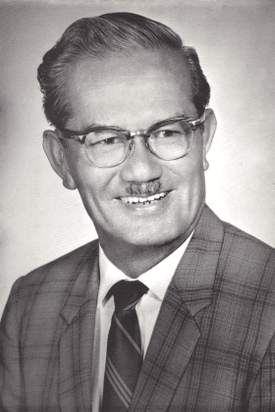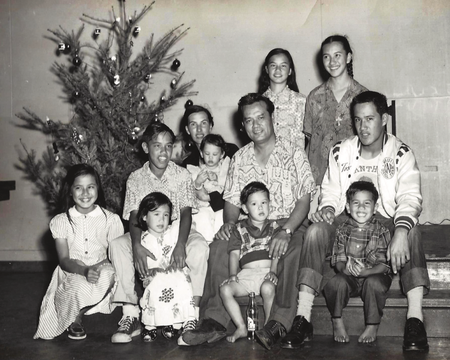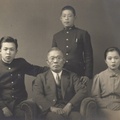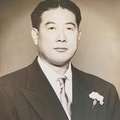In the buildup to World War II, followed by Japan’s attack on Pearl Harbor in December 1941, the Nikkei community came under suspicion by the United States government amidst concerns that elements of the local population would be loyal to Japan if it attempted a land invasion.
Young Nisei (second generation) Japanese Americans were classified as “enemy aliens,” category 4C, for draft purposes and were prohibited from joining the military. However, many had already been drafted into the Hawai‘i National Guard’s 298th and 299th Regiments and comprised about half of those units. Most of these draftees were formed into a nearly all-Japanese unit, which became the 100th Infantry Battalion (Separate) in June 1942.
Due in large measure to the 100th’s outstanding performance during their training period, along with the volunteer service of the Varsity Victory Volunteers (former University of Hawai‘i ROTC cadets), the restrictions on Japanese American military service were lifted. The call for volunteers for the 442nd Regimental Combat Team was made in February 1943. Almost 10,000 young men volunteered from Hawai‘i and about 2,600 were among the first group sent to Camp Shelby, Mississippi, for training.
Prior to the outbreak of WWII, the U.S. Army had realized that its Japanese language capabilities were deficient. It secretly established the Military Intelligence Service Language School (MISLS) in November 1941 in San Francisco’s Presidio Army base, later moving it to Camp Savage, Minnesota, due to security concerns on the West Coast.
A Hawaiian-Japanese Youth
Gulstan Napoleon Toshisuke “Toshi” Enomoto was born in Kaunakakai, Moloka‘i, on April 23, 1906, and grew up on Maui, graduating from Saint Anthony Boys School in 1923. His father was Japanese and his mother was Hawaiian. He married Annie Leighton McNicoll in 1933 and settled in Kahului. Her father was Scottish; her mother was English-Hawaiian. When World War II began, they had six children.
Nisei Veterans Legacy interim president and eldest son Larry Enomoto recalls the beginning of World War II:
“I was with him on the morning of Dec. 7, 1941, visiting an insurance client in Wailuku. We drove home immediately when we learned by radio of the Japanese attacks on Pearl Harbor and other military facilities on O‘ahu. That night, my father had all of us sleep together in the living room. Within hours of the attack, the government declared martial law for the Territory of Hawai‘i. All civilians came under the military governor’s control and were ordered to black out the light from their houses and cars. I remember my father covering our house’s windows and part of his car’s headlights. From 1942 to 1943, my father continued selling insurance during the day and performed shore patrol duties at night.”
Military Intelligence Service
When the call went out for Nisei soldiers with Japanese language skills, Enomoto volunteered although with a wife and six children he was not required to serve. He enlisted in the U.S. Army Military Intelligence Service (MIS) on Jan. 4, 1944, and attended the MISLS at Camp Savage and later Fort Snelling, Minnesota.
Larry recalls, “I remember attending his enlistment ceremony at Wailuku Elementary School. Afterward, I watched as he and his fellow MIS recruits got on trucks to board a ship at Kahului Harbor bound for the mainland.”
Fellow MIS veteran Dr. Shinye Gima, who grew up on Maui, remembers, “When I volunteered for the MIS in 1944, I was surprised and impressed to learn that Toshi Enomoto had also enlisted in the same cohort. Unlike most of us single men, Toshi had a family, including several children.”
After graduating from the MISLS, Enomoto served as an MIS Japanese language interpreter in the Philippines. After Japan surrendered, he was transferred to Hokkaido, Japan, where overseas Japanese from Manchuria were being repatriated.
During World War II, over six thousand Nisei served in the allied forces performing secret military intelligence work against Japan. Their work dispelled concerns about whether they would be willing to fight an enemy with whom they shared an ancestral background. As early as May 1942 MIS Nisei participated in the Aleutian and Solomon Islands invasions.
The MISLS graduates served in every combat area against Japan. They were assigned to each American military service and “loaned out” to allied forces during the Asia-Pacific war until Japan’s defeat in 1945. They translated enemy documents, interrogated Japanese prisoners of war and intercepted and decoded enemy communications. Captured documents provided valuable intelligence and shaped allied strategy and operations against Japan.
The family has few details on the work the senior Enomoto did while serving with the MIS. The language school graduates were sworn to secrecy when they received their deployed assignments and most of the documentation about the Nisei MIS achievements remained classified after the war and was not available to the public until the mid-1970s. These restrictions explain why so little is known about their contributions compared to their fellow Nisei soldiers who served in Europe.
Return to Civilian Life
Discharged in Honolulu on Nov. 18, 1945, Enomoto returned to family life on Maui. He and Annie had five more children for a total of eleven. He was elected Maui County Clerk in 1948 and held the job for 20 years until 1968 when the Maui County Charter abolished the position.
Of Enomoto’s service as county clerk, Dr. Gima recalls, “To me, Toshi Enomoto was a hero. Any time I was near the County [of Maui] office buildings he was easily identifiable: always with a broad smile; he was a popular public figure. He always wore a shirt and tie with a smile that was part of his persona.”
In 1968, Enomoto ran unsuccessfully for mayor against Elmer Cravalho. The loss ended his political career. He continued his service to the Maui community throughout his life holding leadership positions in religious, civic and veterans’ organizations. He passed away in Wailuku, Maui, on July 22, 1993, at 87. Annie died on September 6, 1971, at 57.
The Enomoto Legacy
Enomoto’s younger brother Edward served in the 100th Infantry Battalion. His first two sons, Lawrence (Larry) and Toshi Jr., served in the Air Force, son Charles in the Army and youngest son Timothy in the Marine Corps. The Enomoto family made a significant contribution to America’s defense through their military service.
Having answered his country’s call during war when he could have stayed home and cared for his family, Enomoto continued to serve his community after the war through elected office and volunteer work. His large family ensured that most Maui old-timers know the Enomoto family through its various connections that span the community.
To learn more about the Nisei soldiers from Maui, please visit the Maui Nisei Veterans Memorial Center at 665 Kahului Beach Road.
*This article was originally published in The Hawaii Herald on June 2, 2023.
© 2023 Byrnes Yamashita








